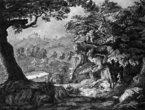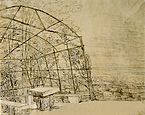Karl Philipp Fohr
You can help expand this article with text translated from the corresponding article in German. (September 2016) Click [show] for important translation instructions.
|

Karl Philipp Fohr, a brother of Daniel Fohr, was born at Heidelberg in 1795. He started his studies of painting with Friedrich Rottmann, and was largely self-taught. In 1810 he was discovered by the painter Georg Wilhelm Issel, who invited him to Darmstadt in 1811. There Johann Philipp Dieffenbach introduced him to Grand Dutchess Wilhelmine of Hessen, who acted as a patron and placed small orders from him.
Later he studied at the Academy of Fine Arts in Munich, where he became friends with fellow student Ludwig Sigismun Ruhl, from whom he learned painting in oil. Fohr dropped out of the Academy to travel on foot to northern Italy, and arrived in Rome in 1816[1]. He briefly joined the circle of the Nazarenes, but increasingly developed his own style. In Rome, he shared a studio with the landscape painter Joseph Anton Koch, whose paintings influenced Fohr's style.
One of Fohr's most important works is the design for a group portrait of German artists in Rome at the Café Greco.
On June 29 1818 Fohr drownd whilst bathing in the river Tiber with his friends Carl Barth, Johann Anton Ramboux, and Samuel Amsler. To raise funds for a monument in his memory, they created a print after a drawing of Fohr by Barth. Samuel Amsler produced the print, as Barth was too distressed to make the print himself.
See also
- List of German painters
- (in Italian) The waterfalls of Tivoli
- (in Italian) Ancient Greek Coffee
Selected works
-
Knight before the Charcoal Burner's Hut, 1816, now in the Alte Nationalgalerie
-
The Waterfalls of Tivoli
-
Lindenfels, 1812, drawing
-
Ruin of the Tiefburg at Handschuhsheim, 1813-1814, watercolor over graphite, now in the J. Paul Getty Museum
-
Summer house and stone table in the English Garden of Heidelberg Castle, before 1816
-
Landscape near Subiaco, 1817, now in the Schlossmuseum Darmstadt
-
Heidelberg Castle
References
- ^ "Carl Philipp Fohr". British Museum. Retrieved 24 April 2018.
 This article incorporates text from a publication now in the public domain: Bryan, Michael (1886). "Fohr, Karl Philipp". In Graves, Robert Edmund (ed.). Bryan's Dictionary of Painters and Engravers (A–K). Vol. I (3rd ed.). London: George Bell & Sons.
This article incorporates text from a publication now in the public domain: Bryan, Michael (1886). "Fohr, Karl Philipp". In Graves, Robert Edmund (ed.). Bryan's Dictionary of Painters and Engravers (A–K). Vol. I (3rd ed.). London: George Bell & Sons.
External links
![]() Media related to Karl Philipp Fohr at Wikimedia Commons
Media related to Karl Philipp Fohr at Wikimedia Commons







